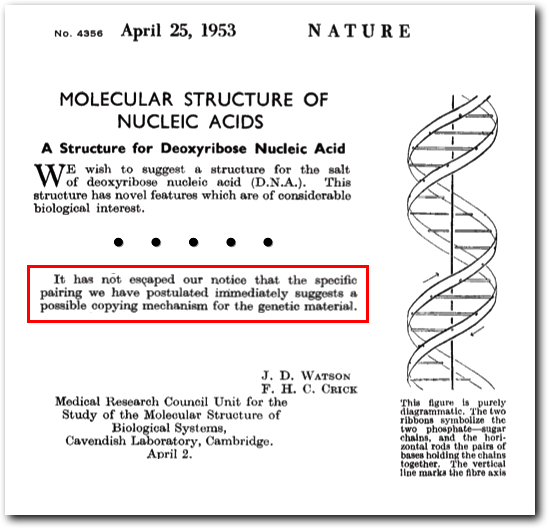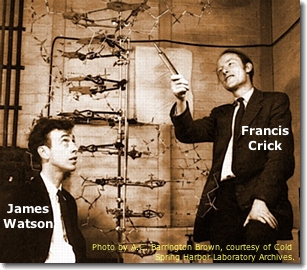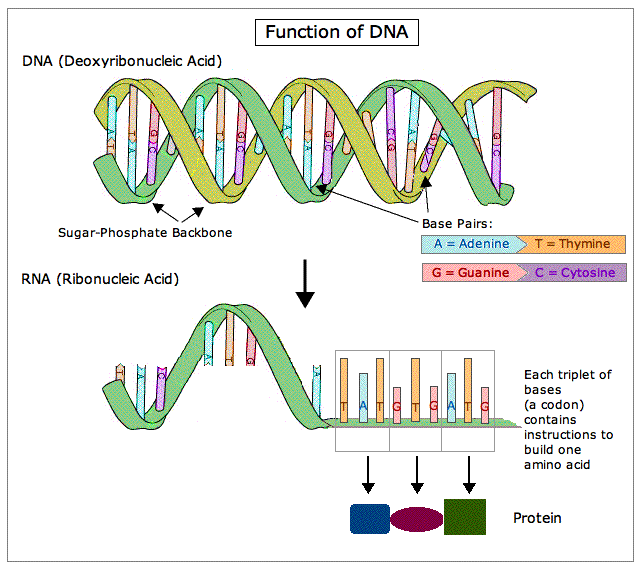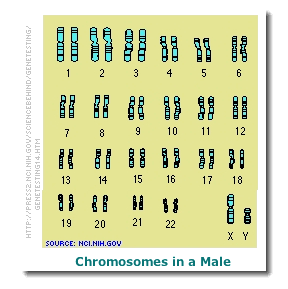|
January 16, 2025 |
PSY 340 Brain and Behavior Class 03: Genetics and the Evolution of Behavior |
|
|
January 16, 2025 |
PSY 340 Brain and Behavior Class 03: Genetics and the Evolution of Behavior |
|
QUESTION: When we use the word "gene" what do we are we saying? What is a "gene"?
ANSWER: Two different (though related) meanings
(1) An inherited biological unit or factor that determines some physical trait [= Mendelian genetics]
and
(2) Inherited molecule(s) or sequences of DNA which give the code(s) or instructions for the production of specific proteins within cells [= Molecular genetics]
Mendelian Genetics (Origins)
Some Examples
Dominant Trait
Recessive Trait
Tongue Rolling
Can
Cannot
Ear Lobe
Hangs Free
Attached
Hand Clasping
Left Thumb on Top
Right Thumb on Top
Hitchhiker's Thumb
Straight Thumb
Bent Thumb
Hair
Curly
Straight
Other Traits
Dimples
No Dimples
Freckles
No Freckles
Farsightedness
Normal Vision
Normal Vision
Nearsightedness
Low sensitivity to Poison Ivy
High Sensitivity to Poison Ivy
The German Catholic monk, Gregor Mendel (1822-1884), in the 19th century worked out rules of inheritance through genes. Though he did not know what they were made of, his research demonstrated that some type of unit or structure passes intact from generation to generation. And, these units cause a living organism to have a particular trait.
Molecular Genetics (DNA): Origins


We now know that these genes are located on stretches of the chromosomes (long strands of genes) which are made of the double-stranded ("the double helix") molecule DNA (Deoxyribonucleic Acid). In the most famous NATURE article published in 1953 (see above), James Watson and Francis Crick (who died in 2004) described the basic molecule, DNA by which genetic information is transmitted from parents to offspring. Later researchers determined how these long strands of DNA actually work. They won the 1962 Nobel Prize in Physiology or Medicine for their work.
The strands of DNA act as templates or models for the creation of ribonucleic acid (RNA) molecules (which are single strands). RNA, in turn, serves as the template or model to make (synthesize) protein molecules (see figure on left below).


![[DNA Strand
Animated]](../graphics/ADN_animation.gif)
Chromosomes & Genes
Human beings have 23 pairs of chromosomes
(see above)
![[Gene]](../graphics/gene.png)
The Human Genome. Each of us has a "genome," that is, all of the genes found in our DNA that code for building proteins. Each gene is a sequence of DNA which codes for a protein. At one time, researchers thought that humans probably would have 50,000 to 150,000 genes. Then, the first results of the Human Genome Project were reported in 2001 and scientists were shocked to find far fewer genes than they had predicted. At first, the estimate was 35,000 genes. Then, in 2008 scientists at MIT and Harvard said humans only have about 20,500 genes (Broad Institute of MIT and Harvard, 2008). And, in 2014 an international research group reported that there "may be as few as 19,000 human protein-coding genes" (Ezkurdia et al, 2014)
Heritable (Simple) Traits (Mendelian Genetics)
Most genes are passed across generations in pairs: one from the father and one from the mother. If we receive identical genes from each parent, we are homozygous for that gene. If we receive different (unmatched) genes from our parents, we are heterozygous for that gene.
Some physical characteristics, e.g., eye color, are determined by genes which can be dominant, recessive, or intermediate. A dominant gene causes its trait to be expressed whatever the other gene might be while a recessive gene causes its trait only if the other gene in the pair is also recessive. If both parents have a dominant gene for a trait, their offspring will receive identical genes for that trait, i.e., they are homozygous for the trait. However, if their parents have one dominant and one recessive gene themselves for the trait, the parents are considered heterozygous for the trait. The results of transmission are seen in the diagram on the right. This shows the transmission of eye color (brown vs. blue). Some genes are also considered to be intermediate between dominance & recession.
Note: DOMINANT ≠ MOST FREQUENT. A recessive gene may be widely present across populations and a dominant gene relatively infrequently present.
- Examples of significant physical disorders based upon Mendelian genetics (Dominant or Recessive genes)
- Albinism (recessive; the complete or partial absence of pigment in the skin, hair and eyes)
- Color blindness
- Cystic fibrosis
- Duchenne muscular dystrophy
- Hemophilia
- Hereditary breast–ovarian cancer syndrome
- Huntington's disease
- Phenylketonuria (will be discussed below)
- Sickle-cell disease
Intermediate Traits. There are some physical traits and medical illnesses that are the results of a single gene as noted above: for example, sickle-cell anemia, cystic fibrosis, muscular dystrophy, Huntington disease, and Tay-Sachs disease. These are called Mendelian disorders.
But, what about the notion of an "intermediate" (not dominant and not recessive gene)? Note that many traits which we once thought were controlled by a single dominant vs. recessive gene are now known to be the results of multiple genes, e.g., at least 10 genes are involved in eye color and more than 180 genes in how tall people grow up to be.
How did scientists find this out? The image to the right shows a figure from the study of Liu et al (2010) who discovered the multiple number of genes involved in eye color. What they did was to photograph the iris (the part of our eye that is colored) of many thousands of people with a high-definition camera. Then they looked at how there are many subtle differences in the hue (the actual color) and the saturation level (how pure the color is) of these eyes and compared their findings to the full genome of these individuals. Thus, they found that the actual "color" of the eye--in all its subtle differences--are the results of multiple genes contributing to the differences. [Note that I lightened the actual image from Liu et al, 2010, in order to illustrate the notion of gradations of color (hue vs. saturation).]
Genetic Changes (Molecular Genetics)
- Mutations: changes in base pairs (Adenine-Thymine; Guanine-Cytosine)
- The human FOXP2 gene differs from the version in other primates by only 2 base pairs. But, as we will see later this semester, these changes made it possible for humans to develop spoken language.
- (Micro)-duplication or (micro-)deletion: tiny mistakes begin to creep into the genome of an individual during reproduction.
- Some researchers suggest that microduplications or microdeletions are partial explanations for the development of schizophrenia.
Epigenetics = gene expression changes without modification of the DNA itself
- Experiences in gestation and early development may create chemical changes that directly affect when or if the genes in our DNA are expressed or not.
- E.g., malnourished mother rats give birth to offspring which, in the presence of a lot of food, tend toward greater obesity and heart disease (compared to offspring of non-malnourished mother rats).
- For DNA to express itself, it must unwrap sufficiently from the histone molecules around which it wraps itself.
- Various changes may involve either acetyl groups [COCH3] or methyl groups [CH3] which are either added to or removed from the histone tails of the histone molecules. These changes make it either harder or easier for the DNA to express itself and, thus, either turn off or turn on various genes.
- Methyl group (CH3) inactivation: Various significant early environmental stressors can cause a methyl group to attach itself to a gene to inactivate it. This inactivated gene can get passed on to the next generation.
- "There is increasing evidence that epigenetic modifications are transgenerational (inherited through multiple generations) in a variety of species. Examples include coat color in mammals, eye color in Drosophila [fruit fly], symmetry in flowers, and now longevity in C. elegans [a type of tiny worm]." (Rogers, 2012)
- The major example found so far in humans involves "the synthetic estrogen compound diethylstilbestrol (DES), which was used in the mid-20th century to prevent miscarriages in pregnant women. DES, however, dramatically increases the risk of birth defects. It is also associated with an increased risk for vaginal and breast cancers in daughters and an increased risk of ovarian cancer in maternal granddaughters of women exposed to DES during pregnancy." (Rogers, 2012)
Heredity & Environment
Most variations in behavior are results of combined influences of many genes (= polygenetic inheritance) and environmental conditions. Behaviors always develop as the joint result of the interaction of these two factors.
Heritability or the heritability index (H2): estimate of how much variation or differences in a characteristic across a population are due to differences in heredity. Range from 0 (no influence) to 1 (totally heritable influence). Note this is a measure of the variability of the characteristic, NOT a measure of the average level of the characteristic. It is generated by comparing fraternal and identical twins and how much they both share a particular trait.
A different way of understanding the heritability index: "“…the heritability index tells you how much you could improve the accuracy of a prediction about one identical twin, given a measurement of the same variable obtained from the other identical twin, as compared to typical fraternal twins measured for the same trait. If traits are highly correlated in identical twins, but not so much in fraternal twins, then a trait has a high heritability index.” (Dewey, 2017-2018, italics added). So, if we had a heritability index of 0.70 for a particular trait and we know that one identical twin has that trait, our error of predicting that trait in the other identical twin is reduced by 70%.
Consider a characteristic such as high blood pressure (e.g., 120/70 or 145/95 or 110/60). Let us say that we measure the blood pressure among two different groups (populations) such as African-American and Italian American adults and, then, calculate an estimate of heritability. Suppose we come up with the following hypothetical (made-up) data
Population Average BP 50% fall within the range of Heritability (H2) African American
145/87 127/77 to 150/93 0.70 Italian Americans 137/81 120/73 to 148/89 0.40 What do these data tell us?
- African American adults have a higher average blood pressure than Italian Americans
- About 70% of the variability or range of BP in African American adults is due to genetic factors while only 40% of the variability of BP among Italian Americans is due to genetic factors.
- But, we don't know why the AVERAGE BP is different between these groups and we cannot say that genetics is the reason for the higher level among African Americans compared to Italian Americans
Thus, be very very careful when you read stories about the heritability of intelligence across different races. Those data only tells about the proportion of variation within each group that comes from genetics, not why the average level of intelligence may be at a certain level.
- We might speculate that African American blood pressure levels are less the result of dietary choices or environmental stress compared to Italian American blood pressure levels. But, we would need more research to determine this. As noted below, extraordinarily high heritability rates can actually be altered by changes in an environment.
Research on heritability comes from these research approaches:
- Twin studies (looking at monozygotic (MZ) [= from one egg] vs. dizygotic (DZ) twins [= from two eggs]).
- Note, by the way, that a recent study (Josson et al., 2021) of 387 pairs of identical twins in Iceland has found that there were an average of 5.2 mutations in their genomes early in development and 15% had higher levels of differences. These data indicate that while "identical twins" are very very similar to each other, they are not absolutely identical in the genes found in their body's cells.
- Adopted children by comparing child to biological parent (heredity) vs. adoptive parents (non-heredity)
- Examining specific genes as they appear across families (grandparents, parents, children, cousins, etc.) or among people with a specific disorder (e.g., depression)
- Not in book: Genome-wide Association Studies (GWAS) and Genome-wide Complex Trait Analysis (GCTA): The actual genome of a large population of people is examined to see if there is a relationship between some particular disorder and specific genes (particularly, SNP or single nucleotide polymorphisms, that is, different variations of a particular gene). An estimate of heritability can be made across large populations through GCTA (Plomin & Deary, 2015).
- "All psychological traits show significant and substantial genetic influence" (Plomin et al, 2016, p. 4)
- Such traits include "cognitive abilities and disabilities, psychopathology, personality, substance use and abuse, and health psychology".
- "No (psychological) traits are 100% heritable" and generally range from 30% to 50% (Plomin et al, 2016, p. 5).
- "Heritability is caused by many genes of small effect" (Plomin et al., 2016, p. 6).
- Indeed, as Ball (2023) argues, "“Even for traits that show a strong heritability, such as height, the genetic component derives from the tiny effects of many genes rather than big effects from just a few…Sometimes the polygenic nature of traits is extreme, and hundreds or even thousands of genes might be implicated” (pp. 90-91, emphasis added).
- "Most environmental effects are not shared by children growing up in the same family" (Plomin et al, 2016, p. 12). Families tend to function in such a way that each child actually experiences a somewhat different environment as they grow up. Furthermore, for many traits, genetic variability rather than environmental differences accounts for differences among children in the same family.
Problems in Heritability Research
- Difficult to tease apart genetic influences (heredity) from prenatal influences (experiences during gestation in the womb)
- E.g., Criminals may have given their children genes tending toward criminal activity, but they also have created environments which may have effects on growing fetus.
- Multiplier Effect: extremely small genetic-based behavioral differences (e.g., greater likelihood to anger) may trigger responses that magnify the effect of that small behavior.
- E.g., child with small athletic advantages early on may receive a lot of early training. By adulthood, the small advantage from genetics has magnified into much greater achievements in the sport.
Environmental Modification
- Because heritability is an interactive effect, even the effects of high heritability can be modified by changing the environment.
The Evolution of Behavior
- Phenylketonuria (PKU): intellectual deficiency (cognitive decline) caused by inability to metabolize phenylalanine, an amino acid. Diet can control PKU for the most part and render the disorder much less damaging to the person.
- Note that the diet is very difficult: No meats, eggs, dairy products, grains, or the artificial sweetener aspartame (NutraSweet).
- Additional problems associated with vitamin deficiency and other nutritional issues tend to arise in adulthood.
Corrections to WRONG IDEAS about evolution
- Use or disuse of a body structure or behavior does not pass down to the next generations (= Lamarckian evolution is wrong though the findings of epigenetics (above) has begun to challenge this notion).
- Genes create adaptive responses to particular environments, that is they increase fitness (= the likelihood that one will pass one one's genes to a new generation). Thus, what is fit in one environment might not be in a different one.
Brain Evolution
- One explanation for humans' larger and more complex brain comes from our diet. Cooking food made it easier to digest. Hunting in groups provided more food than any individual could acquire. Further, we have genes which transport more glucose to our brains (rather than our muscles) than happens in other primates.
Evolutionary Psychology (aka SOCIOBIOLOGY) is an approach to psychology and other social sciences founded by Dr. Edward O. Wilson (Harvard U. Biologist who died on Dec. 26, 2021)
- Studies the evolutionary basis for behaviors, mostly social behaviors. Any behavior which is typical of a species probably arose through processes of natural selection. Some human behaviors make no sense except within the context of evolution
- Goose bumps in humans arose via evolution from animals who protect themselves from the cold and makes themselves look larger when threatened by erecting the fibers of their fur ("piloerection").
- Human infant's grasp reflex reflects an evolutionary inheritance from primates who grasped onto their mother's fur as she climbed through trees with the infant on her back.
- Consider what might be the evolutionary function of sleeping? eating fatty foods?
- Altruistic Behavior: action an animal takes that benefits some other individual rather than the actor. Can the cost of altruism be considered to be a benefit which might be inherited? This may or may not be an inherited behavior. But, suppose it is.
- Simple altruism seems unlikely to confer an advantage.
- Reciprocal altruism (I help you if you help me) requires recognition (and, thus, a good set of sensory organs & brain). It is possible that some animals will "cheat" and not actually help the other. So, among many animals, reciprocal altruism may not be a complete explanation. If a particular human culture, though, adds very strong penalties for cheating (= ethical standards), this will increase the effectiveness of reciprocal altruism.
- Kin selection: altruism leads to helping kin which passes at least some genes along to a new generation. Data tend to show that forms of altruism which benefit family members do show up all over the animal (and vegetative) world.
- Group Selection: altruistic groups (as groups and not just individuals) do better overall than less cooperative groups (a controversial theory). This theory shows strength as long as the altruism takes place within the group itself and (as we pointed out above) non-cooperators are expelled from the group.
An Evolving Understanding of Evolution
Most of what I have outlined above is the product of what is called the “Modern Synthesis of Evolution,” a term that was coined in 1943 by Julian Huxley. It is a theory which arose in the 1930s and 1940s and combines both Gregor Mendel’s ideas about heredity and Charles Darwin’s theory of evolution. The discovery of DNA’s structure by Watson and Crick in 1953 seems to have demonstrated that this modern synthesis was reasonably complete as a theory.
However, over the last two decades, there have been various challenges to the “modern synthesis” which claim that this theory needs to be expanded and changed in some important ways. For example
- Niche Construction Theory: Evolutionary biologists such as John Odling-Smee argue that organisms actively change the environments within which they live. They construct new “niches” which, in turn, “cause changes in their local external environments by interacting with them, thereby contributing in fundamental ways to their own and one another’s evolution” (review comment at https://www.amazon.com/Niche-Construction-Life-Contributes-Evolution-ebook/dp/B0CPDRGPFV/ ].
- Organism Development Theory. Similarly, other evolutionary researchers offer a further critique: “that organisms differ greatly in how effective they are at evolving. Whether and how each organism adapts and diversifies depends critically on the mechanistic details of how that organism operates—its development, physiology, and behavior” (and not just upon how genes contribute to survival and reproduction; quote from review comment at https://www.amazon.com/Evolution-Evolving-Developmental-Adaptation-Biodiversity-ebook/dp/B0CZCQC2Q9/).
- Multiple Inheritance Systems: A third argument comes from Eva Jablonka and colleagues who propose that the evolution of organisms is grounded not just in genes (and epigentic processes), but also in two other inheritance systems: behavioral and symbolic (language and similar communicative modes).
I am mentioning this at the end of this lesson to highlight that there is much more to the theory of heredity than simple genetics. If you have any interest in reading about these new approaches, you might look at these references: Ball (2023), Jablonka (2025), Jablonka & Lamb (2014), Lala et al. (2024), Odling-Smee (2024), & Wilson (2015).
Ball, P. (2023). How life works: A user’s guide to the new biology. University of Chicago Press.
Broad Institute of MIT and Harvard (2008, January 15). Human Gene Count Tumbles Again. ScienceDaily. Retrieved January 15, 2008, from http://www.sciencedaily.com/releases/2008/01/080113161406.htm
Dewey, R. A. (2017-2018). Chapter 10. Development. In Psychology: An Introduction [Online textbook]. https://www.psywww.com/intropsych/ch10-development/genetic-influences.html
Ezkurdia, I., Juan, D., Rodriquez, J. M., Frankis, A., Diekhans, M., Harrow, J., Vazquez, J., Valencia, A., & Tress, M. L. (2014). Multiple evidence strands suggest that there may be as few as 19 000 human protein-coding genes. Human Molecular Genetics, 23(22), 5866-5878. doi:10.1093/hmg/ddu309
Jablonka, E. (2025). A new vision for evolution is long overdue [Review of the book Evolution evolving: The developmental origins of adaptation and biodiversity by Kevin N. Lala et al.]. Nature, 637, 539-541. https://doi.org/10.1038/d41586-025-00054-x
Jablonka, E., & Lamb, M. J.(2014). Evolution in four dimensions: Genetic, epigentic, behavioral, and symbolic variation in the history of life (rev. ed.). Cambridge, MA: Bradford Books, MIT Press.
Jonsson, H., Magnusdottir, E. et al. (2021). Differences between germline genomes of monozygotic twins. Nature Genetics. https://doi.org/10.1038/s41588-020-00755-1
Lala, K. N., Uller, T., Feiner, N., Feldman, M., & Gilbert, S. F. (2024). Evolution evolving: The developmental origins of adaptation and biodiversity. New Jersey: Princeton University Press.
Liu, F.l, Wollstein, A., Hysi, P. G., Ankra-Bad, G.,...Kayser, M. (2010). Digital quantification of human eye-color highlights genetic association of three new loci. PLoS Genetics, 6, e1000934.
Odling-Smee, J. (2024). Niche construction: How life contributes to its own evolution. Cambridge, MA: MIT Press.
Plomin, R., DeFries, J. C., Knopik, V. S., & Neiderhiser, J. M. (2016). Top 10 replicated findings from behavioral genetics. Perspectives on Psychological Science, 11(1), 3-23. DOI:10.1177/1745691615617439
Plomin, R., & Deary, I. J. (2015). Genetics and intelligence differences: Five special findings. Molecular Psychiatry, 20, 98-108. doi:10.1038/mp.2014.105
Rogers, K. (2012, January 16). Epigenetics: A turning point in our understanding of heredity. Scientific American Guest Blog. Retrieved January 25, 2012 from http://blogs.scientificamerican.com/guest-blog/2012/01/16/epigenetics-a-turning-point-in-our-understanding-of-heredity/
Wilson, D. S. (2015, April 9) Beyond genetic evolution: A conversation with Eva Jablonka [Online]. ProSocial World. https://www.prosocial.world/posts/beyond-genetic-evolution-a-conversation-with-eva-jablonka
This page was first posted January 19, 2005.